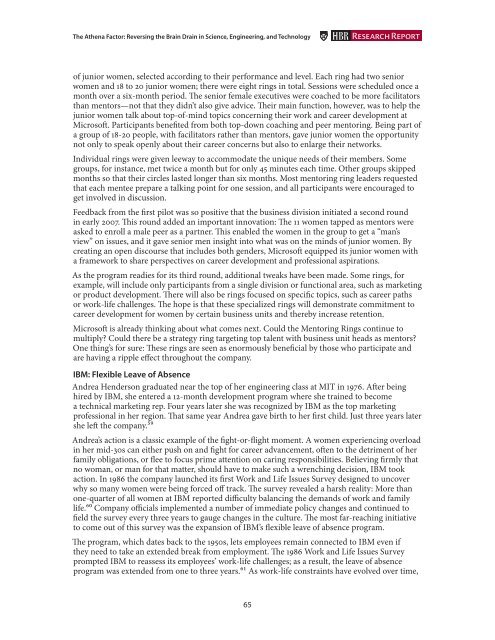HD6060-.A84-2008-PDF-Athena-factor-Reversing-the-brain-drain-in-science,-engineering,-and-technology
HD6060-.A84-2008-PDF-Athena-factor-Reversing-the-brain-drain-in-science,-engineering,-and-technology
HD6060-.A84-2008-PDF-Athena-factor-Reversing-the-brain-drain-in-science,-engineering,-and-technology
Create successful ePaper yourself
Turn your PDF publications into a flip-book with our unique Google optimized e-Paper software.
The <strong>A<strong>the</strong>na</strong> Factor: <strong>Revers<strong>in</strong>g</strong> <strong>the</strong> Bra<strong>in</strong> Dra<strong>in</strong> <strong>in</strong> Science, Eng<strong>in</strong>eer<strong>in</strong>g, <strong>and</strong> Technology<br />
HBR Research Report<br />
of junior women, selected accord<strong>in</strong>g to <strong>the</strong>ir performance <strong>and</strong> level. Each r<strong>in</strong>g had two senior<br />
women <strong>and</strong> 18 to 20 junior women; <strong>the</strong>re were eight r<strong>in</strong>gs <strong>in</strong> total. Sessions were scheduled once a<br />
month over a six-month period. The senior female executives were coached to be more facilitators<br />
than mentors—not that <strong>the</strong>y didn’t also give advice. Their ma<strong>in</strong> function, however, was to help <strong>the</strong><br />
junior women talk about top-of-m<strong>in</strong>d topics concern<strong>in</strong>g <strong>the</strong>ir work <strong>and</strong> career development at<br />
Microsoft. Participants benefited from both top-down coach<strong>in</strong>g <strong>and</strong> peer mentor<strong>in</strong>g. Be<strong>in</strong>g part of<br />
a group of 18-20 people, with facilitators ra<strong>the</strong>r than mentors, gave junior women <strong>the</strong> opportunity<br />
not only to speak openly about <strong>the</strong>ir career concerns but also to enlarge <strong>the</strong>ir networks.<br />
Individual r<strong>in</strong>gs were given leeway to accommodate <strong>the</strong> unique needs of <strong>the</strong>ir members. Some<br />
groups, for <strong>in</strong>stance, met twice a month but for only 45 m<strong>in</strong>utes each time. O<strong>the</strong>r groups skipped<br />
months so that <strong>the</strong>ir circles lasted longer than six months. Most mentor<strong>in</strong>g r<strong>in</strong>g leaders requested<br />
that each mentee prepare a talk<strong>in</strong>g po<strong>in</strong>t for one session, <strong>and</strong> all participants were encouraged to<br />
get <strong>in</strong>volved <strong>in</strong> discussion.<br />
Feedback from <strong>the</strong> first pilot was so positive that <strong>the</strong> bus<strong>in</strong>ess division <strong>in</strong>itiated a second round<br />
<strong>in</strong> early 2007. This round added an important <strong>in</strong>novation: The 11 women tapped as mentors were<br />
asked to enroll a male peer as a partner. This enabled <strong>the</strong> women <strong>in</strong> <strong>the</strong> group to get a “man’s<br />
view” on issues, <strong>and</strong> it gave senior men <strong>in</strong>sight <strong>in</strong>to what was on <strong>the</strong> m<strong>in</strong>ds of junior women. By<br />
creat<strong>in</strong>g an open discourse that <strong>in</strong>cludes both genders, Microsoft equipped its junior women with<br />
a framework to share perspectives on career development <strong>and</strong> professional aspirations.<br />
As <strong>the</strong> program readies for its third round, additional tweaks have been made. Some r<strong>in</strong>gs, for<br />
example, will <strong>in</strong>clude only participants from a s<strong>in</strong>gle division or functional area, such as market<strong>in</strong>g<br />
or product development. There will also be r<strong>in</strong>gs focused on specific topics, such as career paths<br />
or work-life challenges. The hope is that <strong>the</strong>se specialized r<strong>in</strong>gs will demonstrate commitment to<br />
career development for women by certa<strong>in</strong> bus<strong>in</strong>ess units <strong>and</strong> <strong>the</strong>reby <strong>in</strong>crease retention.<br />
Microsoft is already th<strong>in</strong>k<strong>in</strong>g about what comes next. Could <strong>the</strong> Mentor<strong>in</strong>g R<strong>in</strong>gs cont<strong>in</strong>ue to<br />
multiply? Could <strong>the</strong>re be a strategy r<strong>in</strong>g target<strong>in</strong>g top talent with bus<strong>in</strong>ess unit heads as mentors?<br />
One th<strong>in</strong>g’s for sure: These r<strong>in</strong>gs are seen as enormously beneficial by those who participate <strong>and</strong><br />
are hav<strong>in</strong>g a ripple effect throughout <strong>the</strong> company.<br />
IBM: Flexible Leave of Absence<br />
Andrea Henderson graduated near <strong>the</strong> top of her eng<strong>in</strong>eer<strong>in</strong>g class at MIT <strong>in</strong> 1976. After be<strong>in</strong>g<br />
hired by IBM, she entered a 12-month development program where she tra<strong>in</strong>ed to become<br />
a technical market<strong>in</strong>g rep. Four years later she was recognized by IBM as <strong>the</strong> top market<strong>in</strong>g<br />
professional <strong>in</strong> her region. That same year Andrea gave birth to her first child. Just three years later<br />
she left <strong>the</strong> company.59<br />
Andrea’s action is a classic example of <strong>the</strong> fight-or-flight moment. A women experienc<strong>in</strong>g overload<br />
<strong>in</strong> her mid-30s can ei<strong>the</strong>r push on <strong>and</strong> fight for career advancement, often to <strong>the</strong> detriment of her<br />
family obligations, or flee to focus prime attention on car<strong>in</strong>g responsibilities. Believ<strong>in</strong>g firmly that<br />
no woman, or man for that matter, should have to make such a wrench<strong>in</strong>g decision, IBM took<br />
action. In 1986 <strong>the</strong> company launched its first Work <strong>and</strong> Life Issues Survey designed to uncover<br />
why so many women were be<strong>in</strong>g forced off track. The survey revealed a harsh reality: More than<br />
one-quarter of all women at IBM reported difficulty balanc<strong>in</strong>g <strong>the</strong> dem<strong>and</strong>s of work <strong>and</strong> family<br />
life.60 Company officials implemented a number of immediate policy changes <strong>and</strong> cont<strong>in</strong>ued to<br />
field <strong>the</strong> survey every three years to gauge changes <strong>in</strong> <strong>the</strong> culture. The most far-reach<strong>in</strong>g <strong>in</strong>itiative<br />
to come out of this survey was <strong>the</strong> expansion of IBM’s flexible leave of absence program.<br />
The program, which dates back to <strong>the</strong> 1950s, lets employees rema<strong>in</strong> connected to IBM even if<br />
<strong>the</strong>y need to take an extended break from employment. The 1986 Work <strong>and</strong> Life Issues Survey<br />
prompted IBM to reassess its employees’ work-life challenges; as a result, <strong>the</strong> leave of absence<br />
program was extended from one to three years.61 As work-life constra<strong>in</strong>ts have evolved over time,<br />
65


